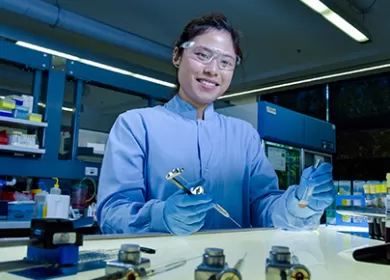What do sugar, 3D printing and stem cells have in common?
They’re all key to growing blood in the lab! It’s a futuristic concept with amazing potential to save lives. Australian Red Cross Lifeblood researchers are harnessing the latest technology to explore the world of blood grown outside of the body.
Why would we grow blood in the lab?
You might be wondering why grow blood in a lab when there are already people donating it? Well, there are a few reasons. Firstly, blood can be in short supply. Only about 3% of the eligible population in Australia donate blood, even though we estimate over half of all adults are eligible to donate. Secondly, some people have rare blood types beyond A, B or O, and there might not always be donations available that are safe for them to receive. Lastly, people who’ve been transfused multiple times can develop an immune response to some of the blood types they’ve received. To avoid this, they need to receive blood donations that are an extremely close match to their own.
Growing blood in the lab could help all these people, plus has potential applications in remote areas and for our defence forces.
Taking inspiration from our bodies
Lifeblood researcher Dr Becky Griffiths is leading the research team developing blood in the lab. She explains:
“The human body can produce around 2.4 million red blood cells per second! That’s heaps more than anyone can grow in a lab yet.”
Having figured out how to produce red blood cells in small quantities using stem cells as a starting material, Becky is now focusing on replicating the hyper-efficient red blood cell factories that are found in all of us. The overall goal is to reduce costs and scale up production of growing cells in the lab.
The upside of sugar
Your bone marrow is the ideal location to grow red blood cells, containing a special cocktail of growth factors to stimulate stem cells to become red blood cells. In the body, these growth factors are furnished with sugar chains called glycans. In fact, almost all cells rely on these sugars to function properly, but research labs around the world have typically used stem cell factors that are sugar free (largely because it’s a bit more difficult to reproduce these factors with the right sugars). Becky has an exciting new collaboration with Prof Daniel Kolarich at Griffith University’s Institute for Biomedicine and Glycomics where she says they’ve found that:
“Including just a small amount of one sugar-coated stem cell factor in our growth cocktail means the red blood cells grow much more efficiently.”
Becky and Daniel are now working to understand the underlying roles of these sugar-modified factors in red blood cell development in a three-year project funded by the Australian Research Council.
From two to three-dimensional
In the lab, red blood cells are grown in flat dishes containing liquid that replicates the special mix of growth factors found in your bone marrow. But as Becky points out:
“Your bones aren’t flat! Bone marrow is a porous structure, like a sponge. This means there’s far more surface area available for red blood cells to grow compared to the traditional flat dishes used in the lab. We’re now making bioengineered scaffolds to mimic this extra space.”
With more surface area to grow on, Becky expects more red blood cells to grow in the same amount of liquid – drastically reducing production costs. This collaboration with Dr Mark Allenby at University of Queensland's School of Chemical Engineering is in its early days, but so far they’ve shown there’s plenty of added space, and the cells seem to grow much more.
Age-appropriate blood
In Australia, only adults can donate blood. But anyone could need blood, including babies who are born prematurely. But adult red blood cells aren’t the same as those made by babies. This is where lab grown blood could fill the gap.
Just like how we can use stem cells to grow adult red blood cells, we can collect paediatric stem cells from the umbilical cord – once it’s not being used by a baby of course! Lifeblood researcher Dr Sara Chiaretti highlights the challenge:
“Paediatric stem cells are geared to make age-appropriate red blood cells, which have key differences from adult red cells in terms of size, flexibility and ability to carry oxygen. But we don’t know a lot about how these changes impact clinical outcomes, so we’re investigating red cell biology as a baby grows, and figuring out the best way to mimic this in the lab.”
What’s next for lab grown blood?
It’s safe to say we won’t be replacing blood donations anytime soon. A clinical trial led by UK National Health Service Blood and Transplant researchers that’s investigating if lab grown red blood cells are safe is due to finish late in 2025, so we will soon be another step along the long road to the blood of the future. For now, donated blood is by far the best way to save a life, so go ahead and book now!







